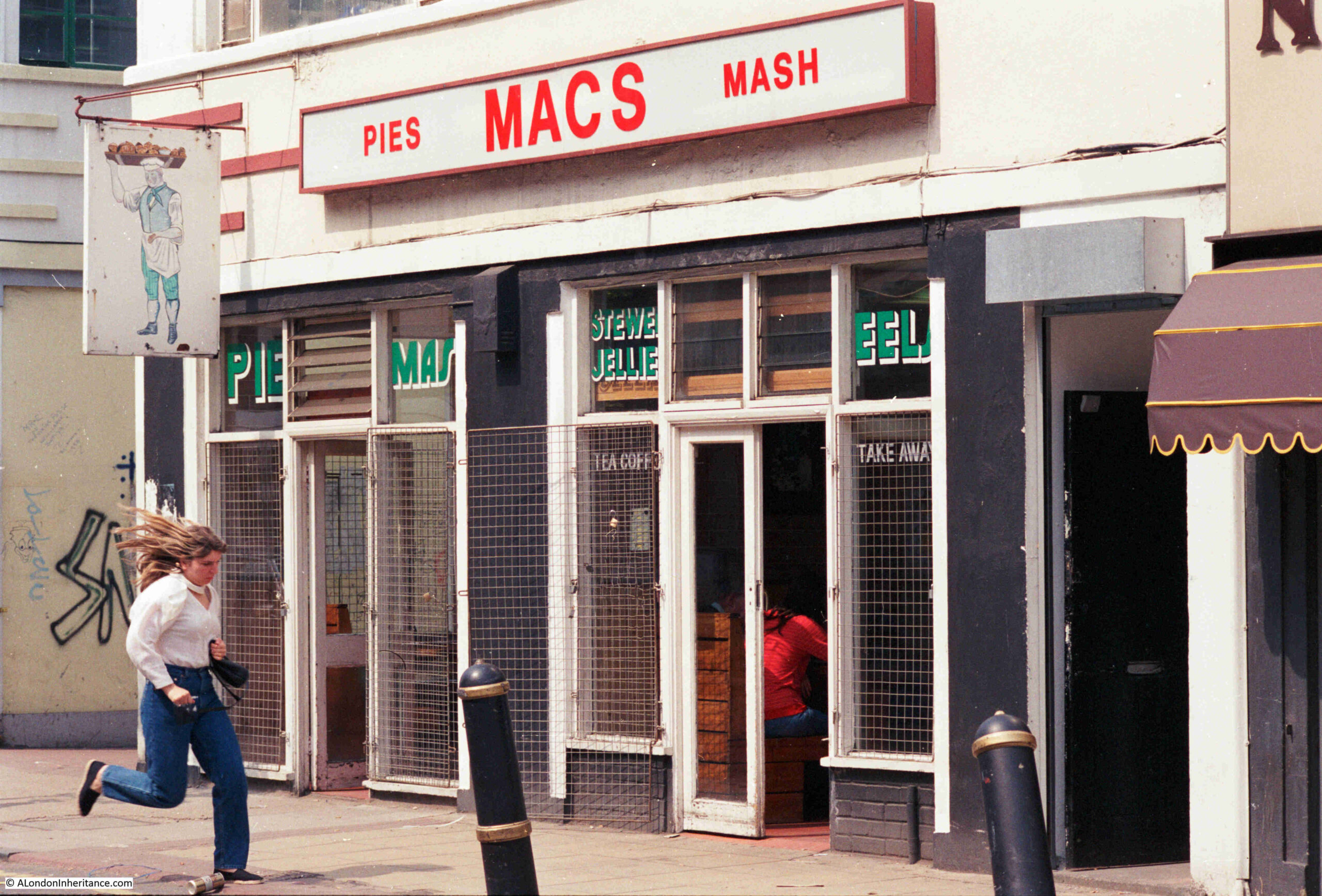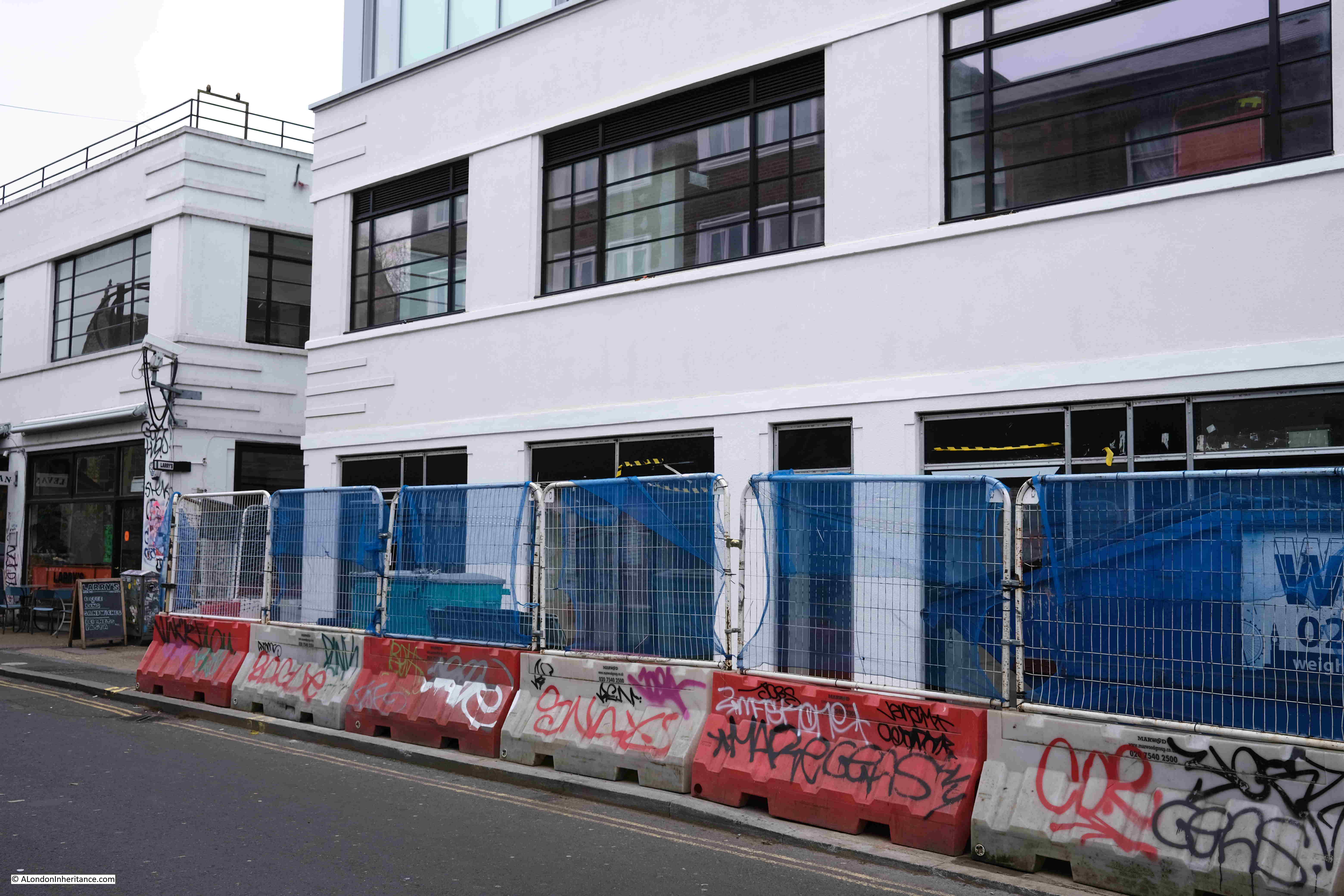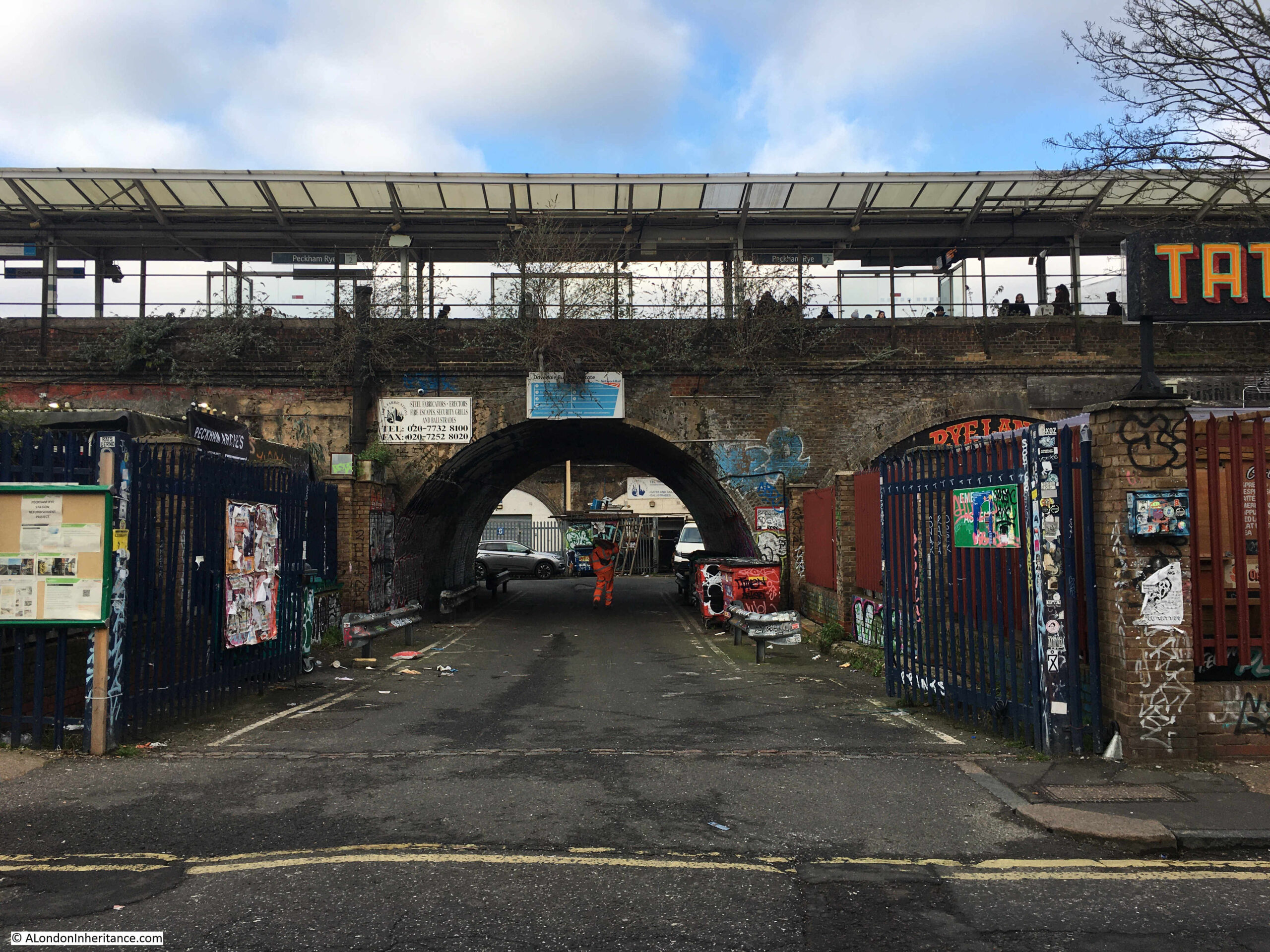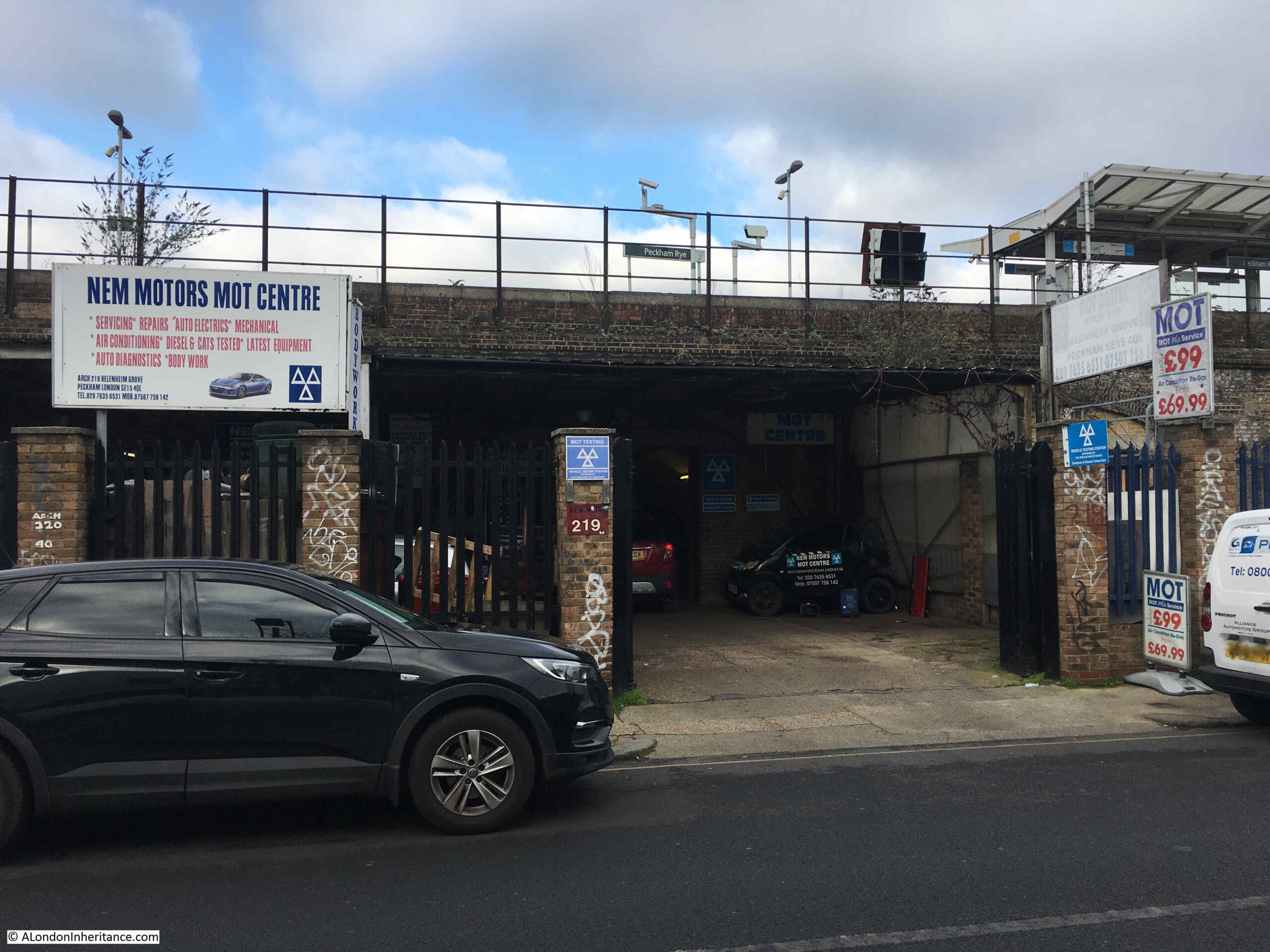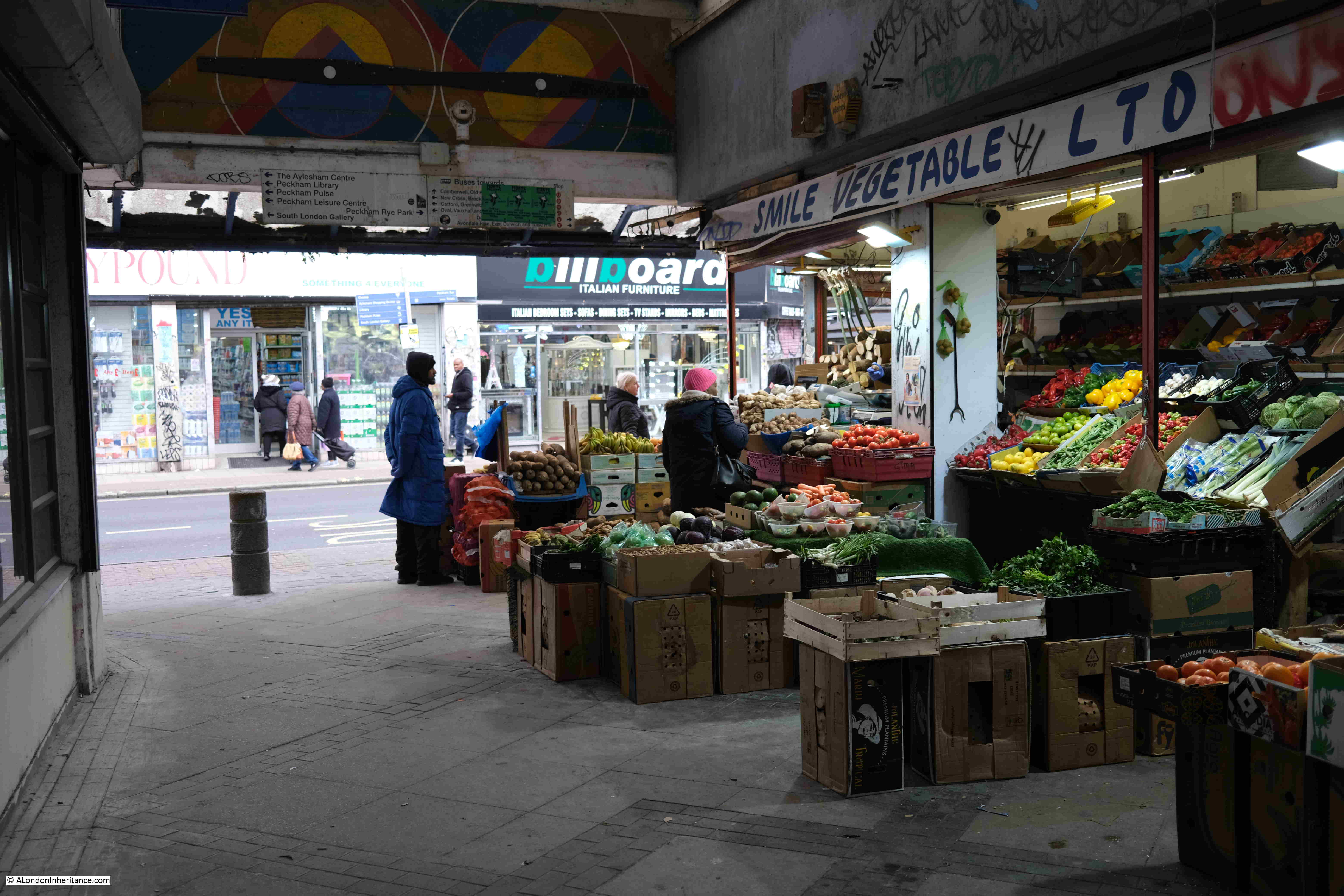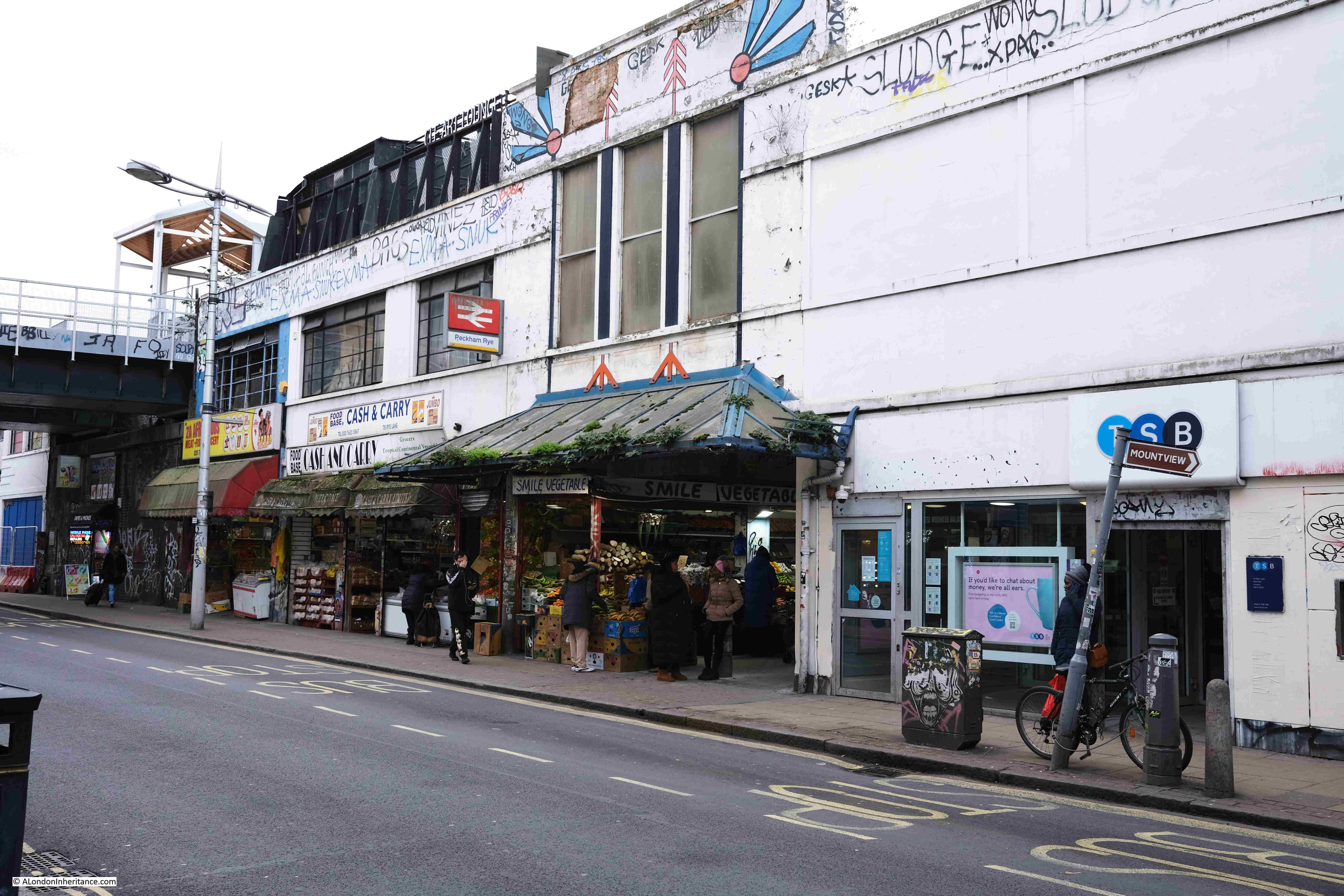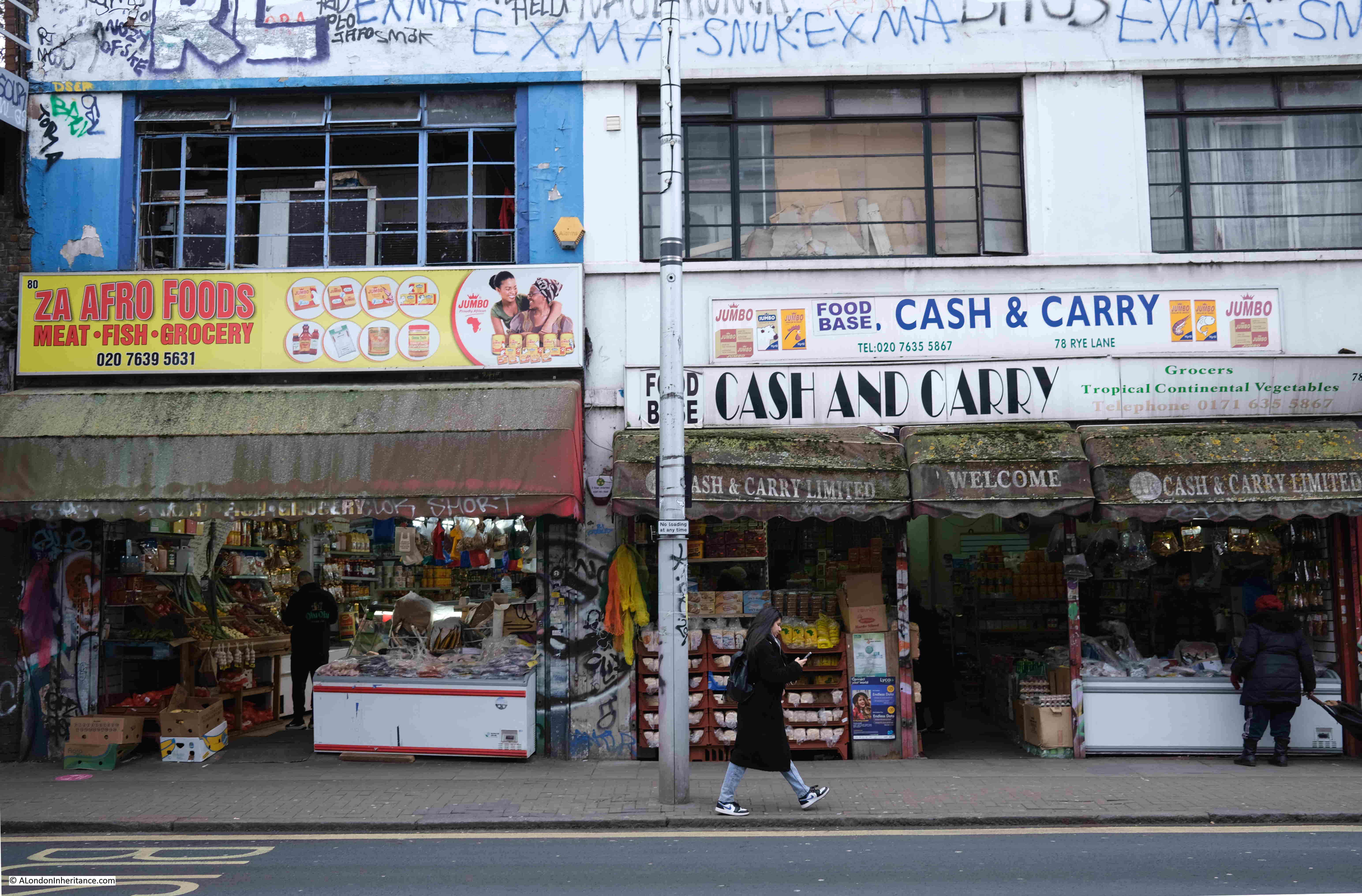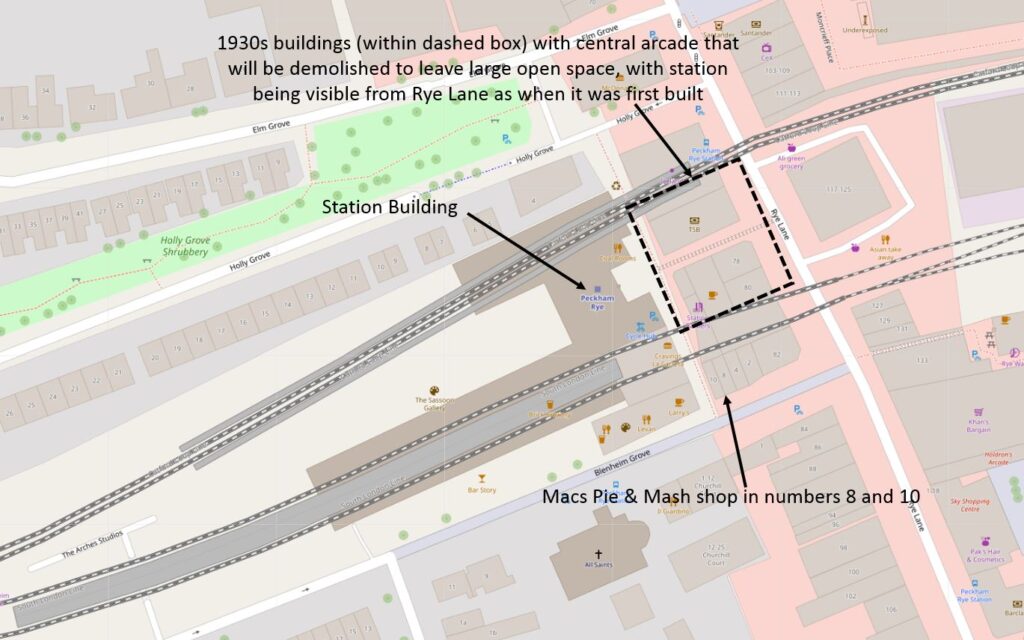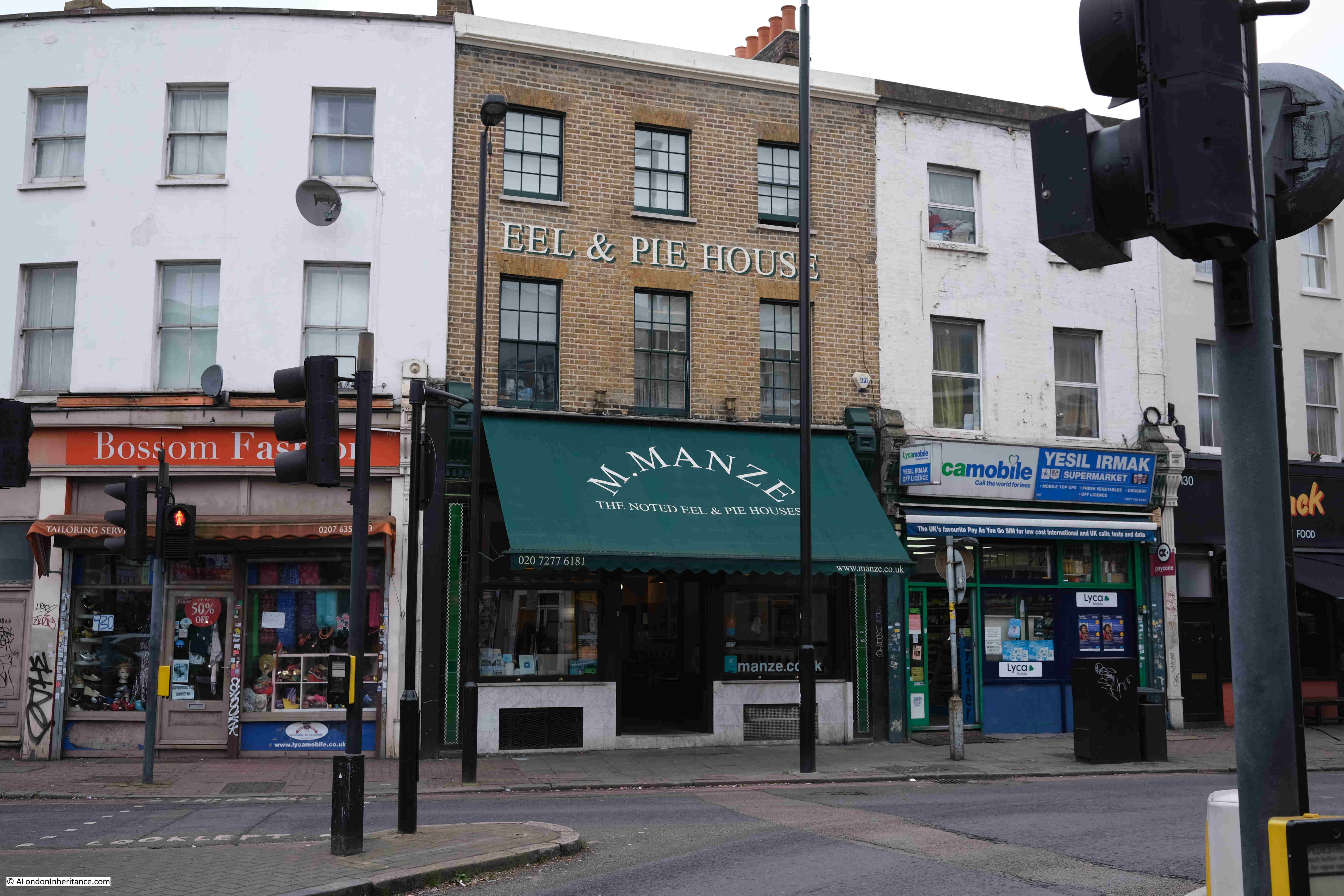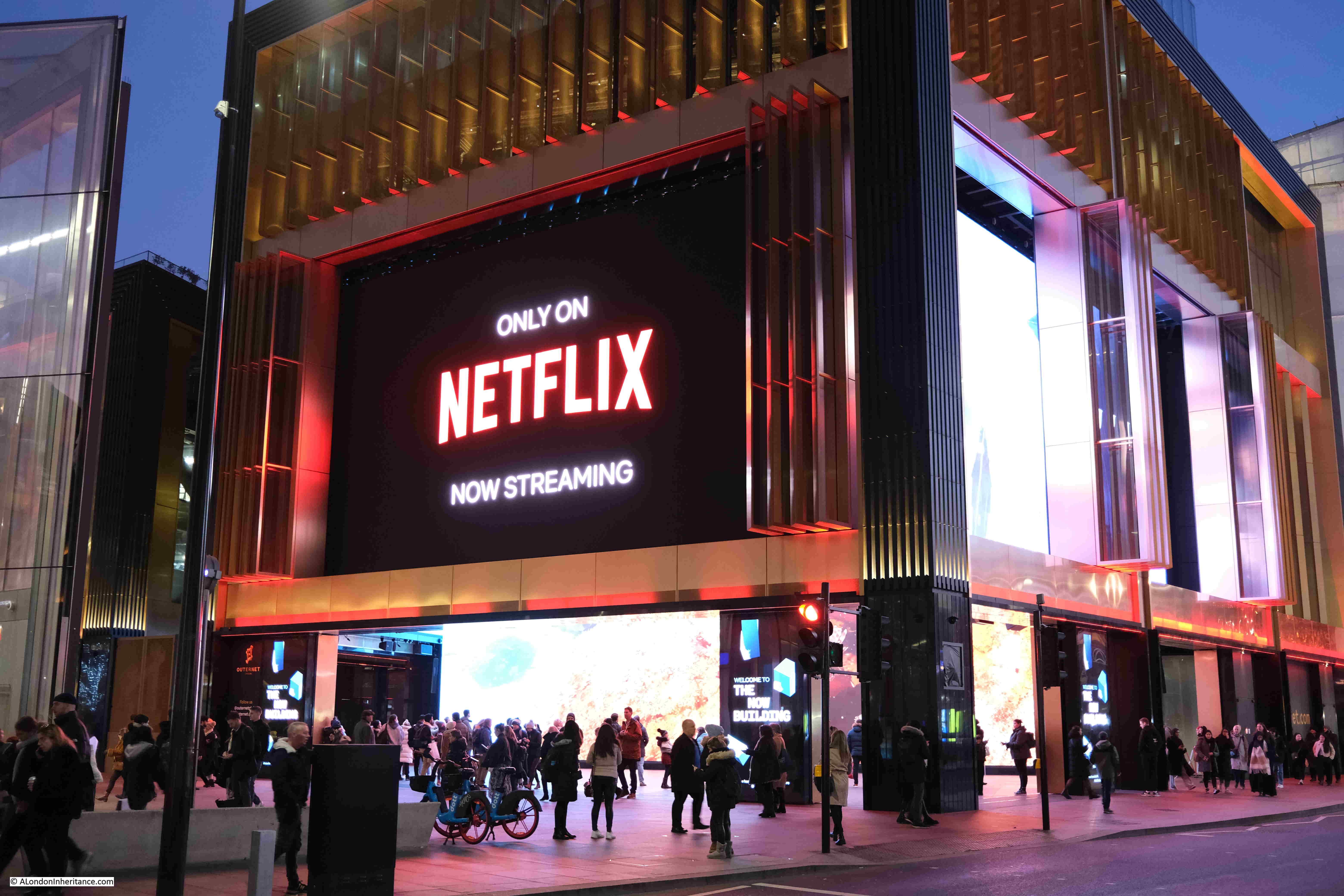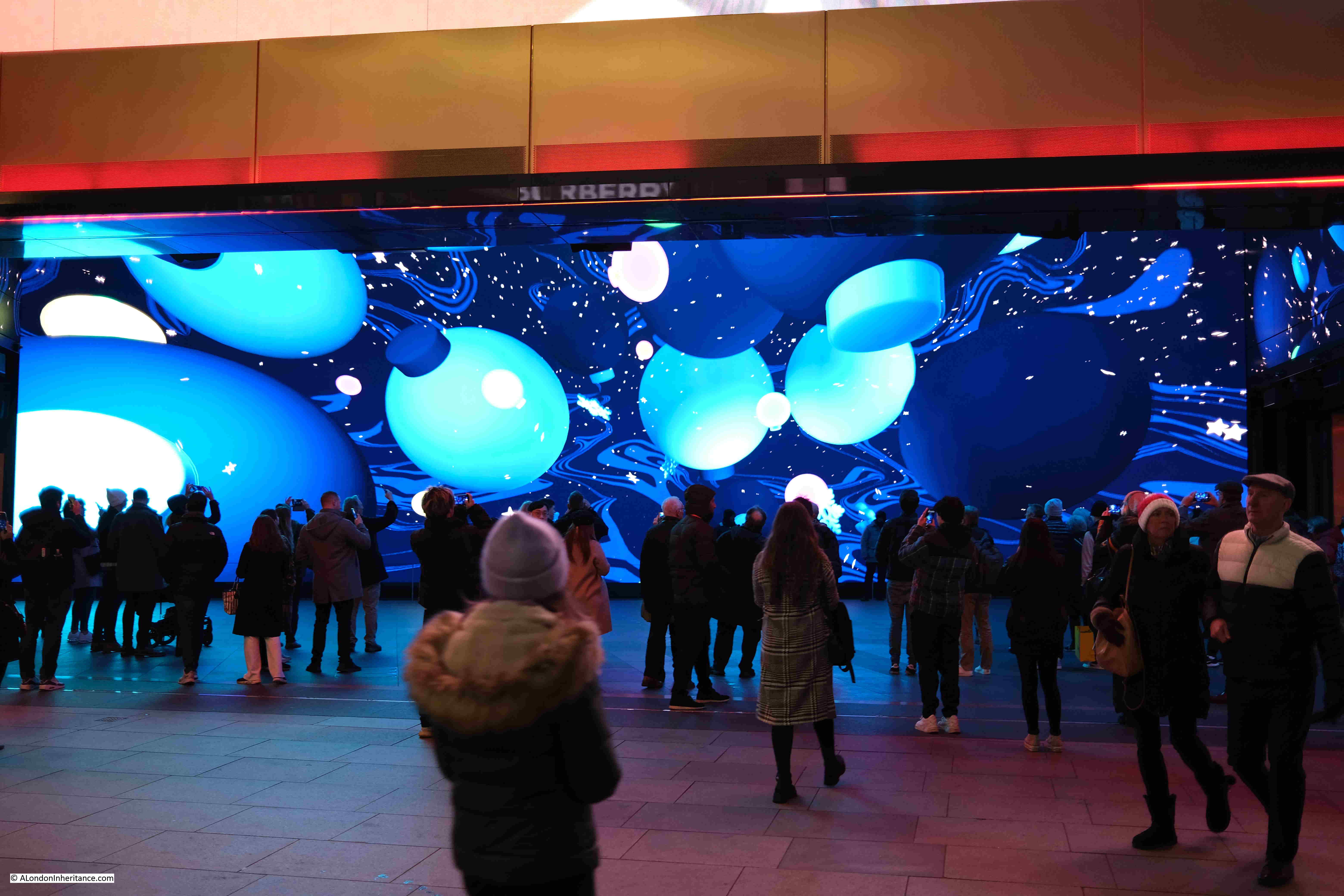For today’s post, I am back in Peckham, in search of some Peckham pubs. There was a problem with the emailing out to subscribers last Sunday, so sorry if you did not receive the post on Macs Pie and Mash in Peckham. If you want to catch up, the post can be found here.
I am really grateful to some of the feedback to the post which included references to Macs Pie and Mash in a Museum of London book titled ‘Eels, Pie & Mash’, which includes the following reference to Macs: “This shop was previously a launderette until Mary and Roy Brannan took it over in 1976 and called it Simple Simon’s after the children’s nursery rhyme.”
As well as the pie and mash shop, there were a number of other photos of Peckham taken by my father in 1986, which I have not been able to identify, although one photo was easy:
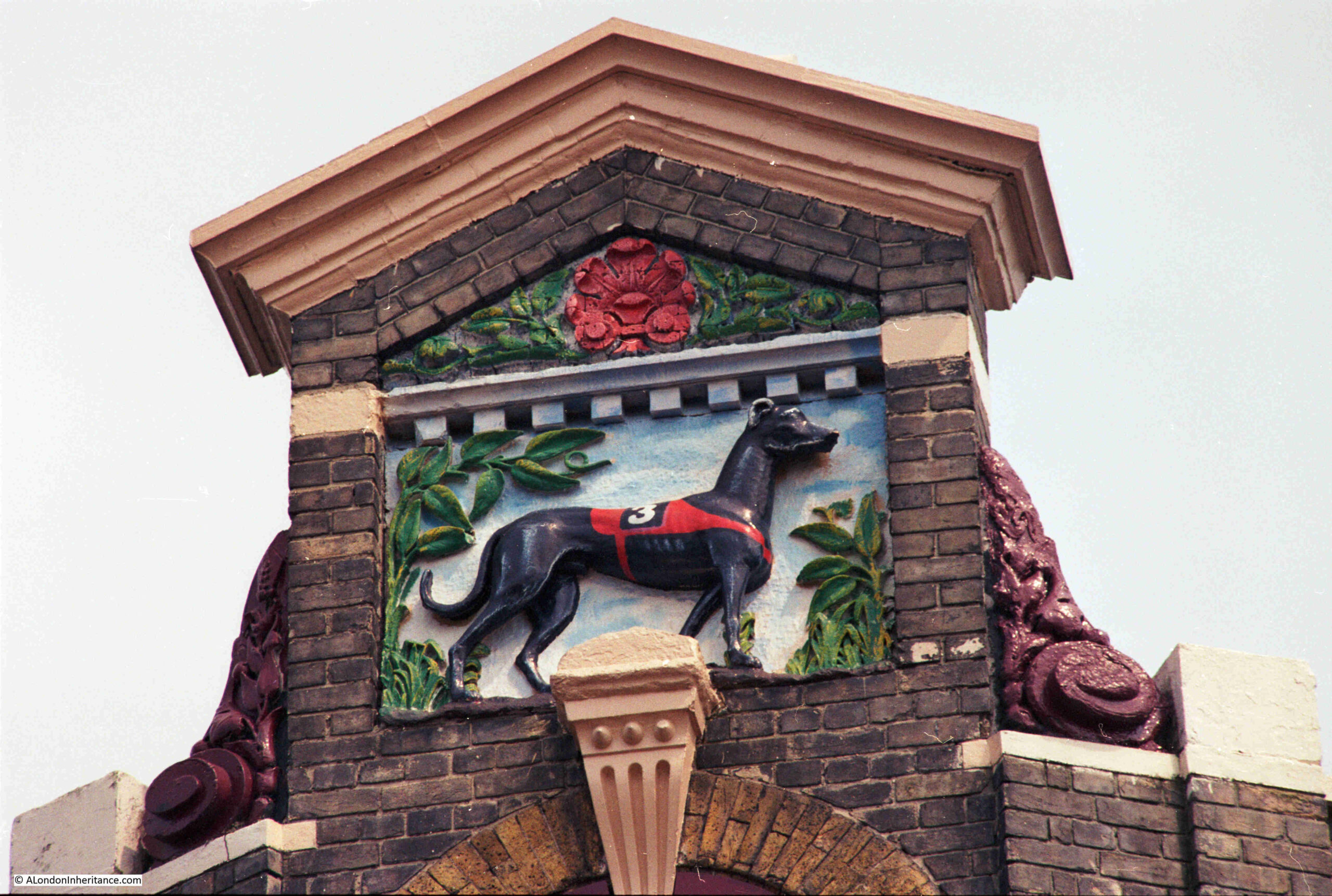
This is on the Greyhound pub on Peckham High Street. The Greyhound is a corner pub and has one of the visual decorations, representative of the name of the pub, on the roof line at the corner.
There were, and still are, a number of this type of pub decorations across London. I have photographed many of them ready for a blog post, but still have a few more to visit.
After finding the location of the pie and mash shop, I walked north along Rye Lane in the direction of Peckham High Street to find the Greyhound. It was a sunny day when my father took the Peckham photos, however with the demands of a weekly blog I have to visit places when I can, and when the weather is not so good, so I was in Peckham on a grey, January day, however some of the shops in Rye Lane do a good job of adding colour to a grey, flat light:
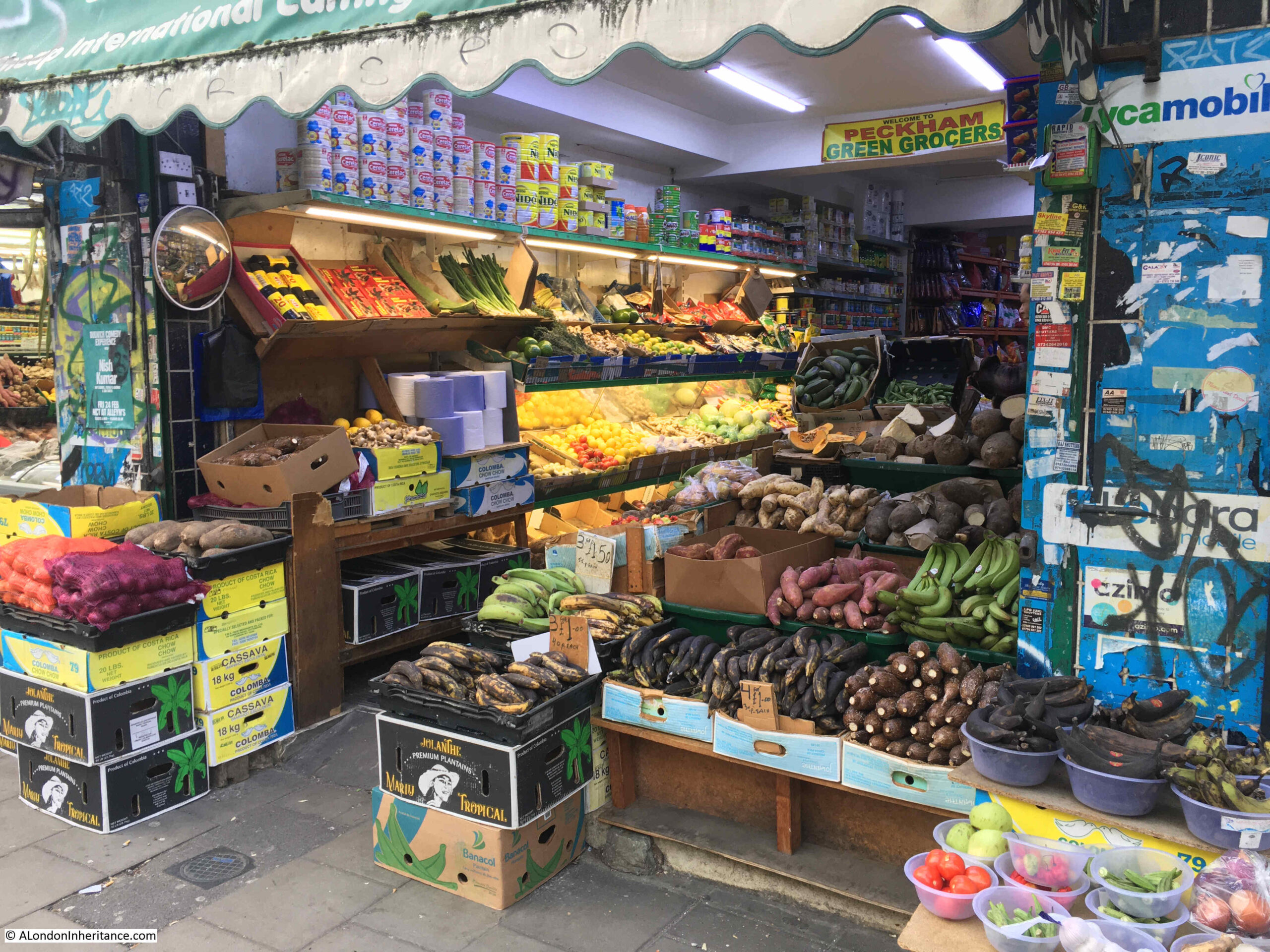
Peckham, in common with most other places in London, once had a very large number of pubs. Many of these were still hanging on in the 1980s and 1990s, but the first couple of decades of the 21st century have seen their number decline dramatically.
Local demographic changes, competition from a considerably increased range of eating and drinking places, cost pressures, etc. have all contributed to the closure of so many pubs.
When a pub closes, they are often demolished, or converted to alternative uses. Where the building remains, it leaves a reminder of the social and cultural history of these local institutions, and I found a number of these in Peckham, starting with:
The Hope, Rye Lane
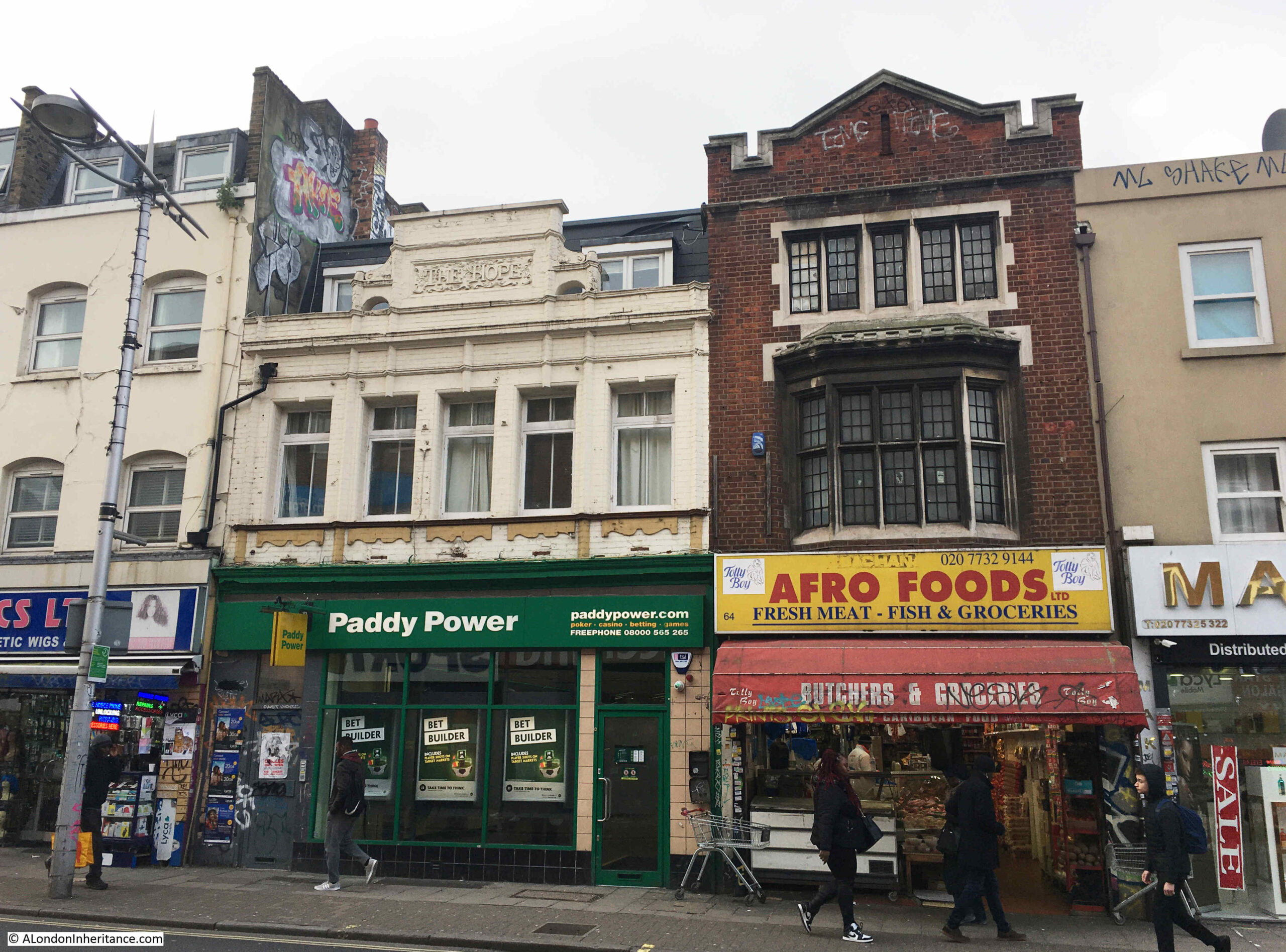
The Hope has now been replaced by a Paddy Power betting shop. The name of the pub can still be seen at the top of the façade, along with some of the original decoration below the first floor windows.
The name of the pub, and vertical decoration between the windows of the first floor were originally the same golden colour as the decoration below the windows.
The Hope closed around 2010, when Paddy Power took over the ground floor.
I cannot find exactly how old the pub was, however I did find an intriguing reference in the Morning Advertiser on the 1st of June 1848 which may indicate the age and origins of the pub and the pub name:
“To be LET, TWO good BEER and ALE HOUSES situated on the outskirts of London, doing 20 barrels per month, besides a good rub in tea, coffee, cooked meat, &c – rents all let off, and both free – price £100, or at valuation. Satisfactory reason will be given by applying at 2, Church Lane, Whitechapel; or Mr. Hope, Greengrocer, Rye-lane, Peckham.”
Unfortunately there is no address given for the two good beer and ale houses on the outskirts of London, however the contact details are for a Mr. Hope in Rye Lane.
There is no way I can confirm this given limited research time, and perhaps I am clutching at straws, however perhaps the beer and ale houses were owned by Mr. Hope of Rye Lane, and perhaps he gave his name to one of them.
The South London Observer provided a good source of all the usual reports of happenings in a 19th and 20th century pub, and an interesting theme was the creative advertising for the Hope when a Mr. George Crump was the landlord from around 1916 to the late 1920s. Some examples:
9th December 1916: “PECKHAM’S NOTED BEER AND WINE HOUSE, THE HOPE, 66, RYE LANE. Mr. George Crump begs to inform the residents of Peckham and elsewhere that he is still supplying the best of everything in Wines, Ales etc.”
2nd of June, 1917: “IMPORTANT NOTICE – The restricted output of beer in no way effects the supply at THE HOPE, RYE LANE, PECKHAM, where Mr. George Crump is still providing the finest Mild Ale and Porter at 4d per half-pint for consumption on the premises only. Cellars always well stocked. Noted house for wines.”
George Crump also seems to have been a bit of a composer:
13th March 1926: “GET THAT SUNSHINE FEELING AND VISIT ‘THE HOPE’ RYE LANE, PECKHAM, where you can see an excellent portrait of GEORGE W. CRUMP by that talented artist Lydia Dreams of ‘Popularity’ fame. GET THAT SUNSHINE FEELING, by George Crump and Joe Archer, sung with immense success by Miss Kitty Collier.”
Lydia Dreams was an artist who had a male persona of Walter H Lambert for some of her paintings, one of which, as the above report confirms, was called “Popularity”. This was a remarkable portrait of many of the music hall artists of the early 20th century, where they are shown, crowded together at Lower Marsh and Waterloo Road.
The painting is apparently held by the Museum of London, however the site dedicated to Arthur Lloyd has a copy online here. No idea what happened to the portrait of Mr. George Crump.
His creative advertising for the Hope pub continues:
18th December 1926: “Prepare for the Festive Season. If you want a Really Merry Christmas you must not fail to have your stock of wines. Mr. Geo. Crump of THE HOPE, RYE LANE, is now offering 5,000 bottles of fine DRURO PORT from 2/9 a bottle.”
22nd December 1928: “THE HOPE, RYE LANE, PECKHAM. Truman, Hanbury and Buxton’s Sparkling Ales. Guinness and Bass always in fine condition. Wines from the Wood and in bottle, of the finest quality.
Specialty Douro port from 3/6 per bottle. Cockburn’s. Sandeman’s, Dow’s etc.”
The above advert concluded with the following wonderful rhyme:
“If you’re feeling alone and there’s no one at home, Don’t get the blues or be snappy, But stroll down the Lane in sunshine or rain, Call in The Hope and be happy.”
George Crump seems to have been the landlord of the Hope for around 18 years, as I found a report on the death of Mrs. S. Crump, who must have been his wife:
16th September 1954: “Mrs. S. Crump. A woman who had served the Peckham public house behind the bar of the Hope, Rye-lane for 18 years, died at the Beer and Wine Trade Benevolent Society Homes. Nunhead, aged 82.
Mrs. Susanna Crump, born at Bethnal Green, had spent 40 years in the district. She was very fond of cats and had pictures and ornaments of them all round her little rooms.”
“Chief mourners at Forest Hill included Mr. and Mrs. G.C. Crump of the Bricklayers Arms , Kender Street, New Cross.”
I suspect that one of the chief mourners, Mr. G.C. Crump was George and Susanna Crump’s son as he had the same first initial as the father. He is noted as being of the Bricklayers Arms in New Cross. I have found multiple family generations in the profession of landlord was common in many London pubs.
A short distance along Rye Lane is Rye Lane Chapel. Obviously not a pub, but an institution catering to the more spiritual needs of the local population:
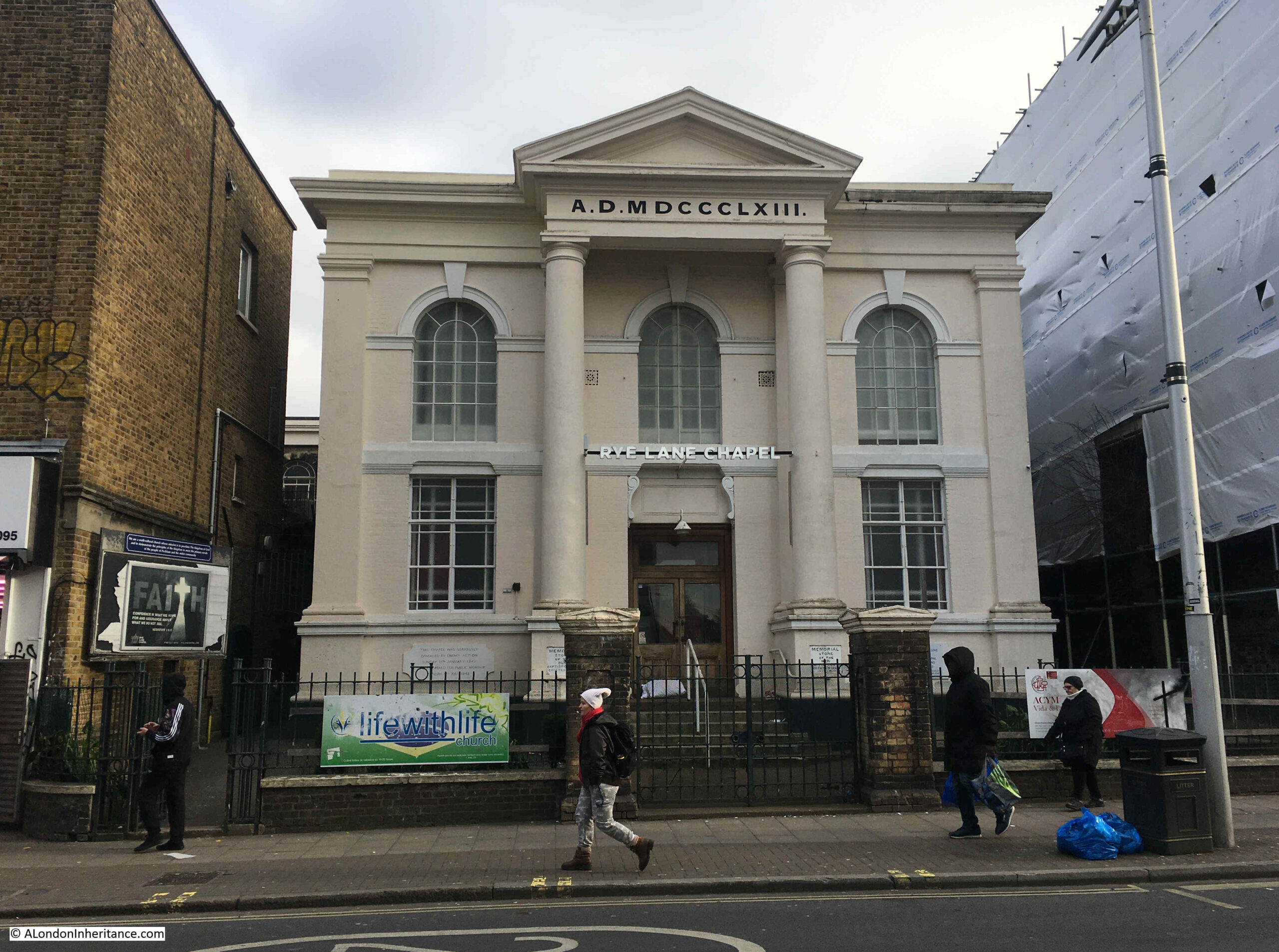
The current building dates from 1863 when it replaced the original chapel which had been demolished to make way for Rye Lane Station. The memorial stone of the original 1819 chapel was retained and is now below the pillar on the left of the entrance. The chapel was very badly damaged by bombing in 1943, but was rebuilt and reopened five years later.
Back to Peckham pubs, and at the northern end of Rye Lane, is the junction with Peckham High Street. Directly opposite is an open pub:
The Kentish Drovers
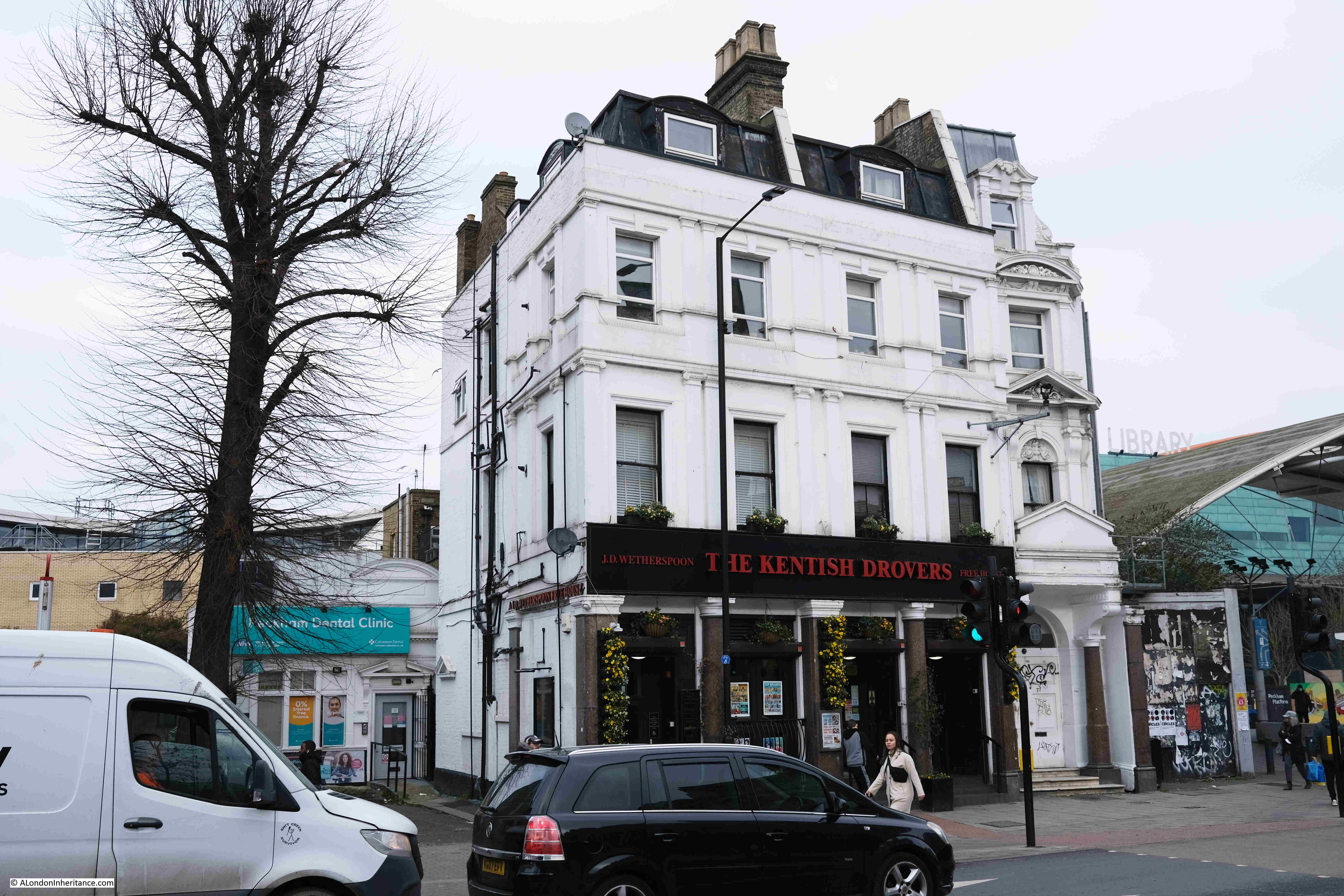
The Kentish Drovers is an old pub, but not the one in the above photo. The current location of the Kentish Drovers was originally a bank, and the pub is now a Wetherspoon’s. It was originally on the opposite side of Peckham High Street, in an area which unfortunately was covered by a very large advertising hoarding so I have no idea if any of the original pub building remains.
The earliest reference I found to the Kentish Drovers was from the Morning Chronicle on the 4th of November, 1805, when the leasehold of a cottage was being offered for sale at an auction at “Mr. Mills’s, the Kentish Drovers, Peckham.”
The description of the cottage is an interesting snapshot of Peckham at the start of the 19th century as it was a “small cottage, with garden and forecourt, pleasantly situated in the orchard.”
Peckham was still very rural at the time of the sale of the cottage, and although this was just over 50 years earlier, Rocque’s map shows that Peckham was very rural at the time:
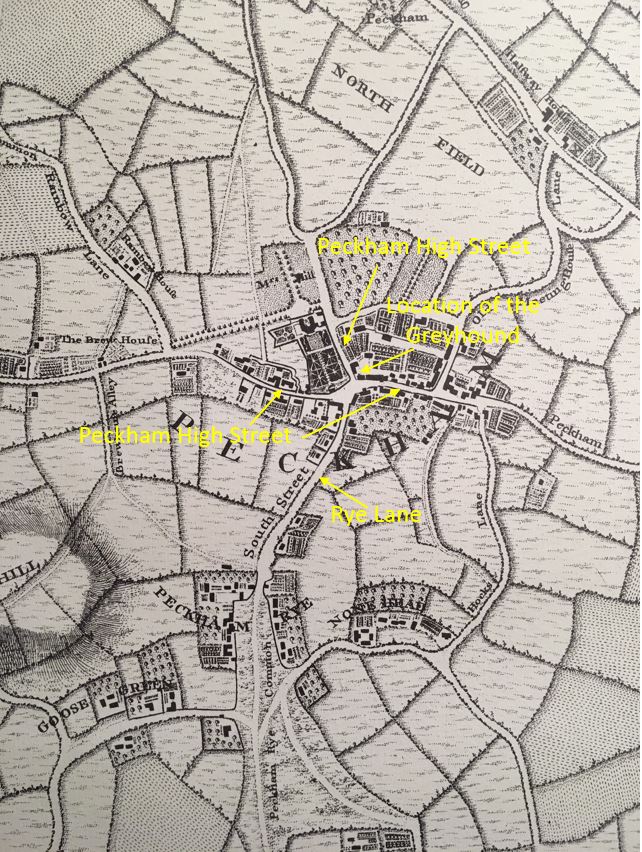
I have marked Rye Lane, as in 1746 it was called South Street, presumably as it led south from the large junction at the northern end of the street, where there is an open space at the junction with Peckham High Street and Peckham Hill Street.
There were a large number of pubs around this road junction, and I have marked the location of the Greyhound, on the corner of Peckham High Street and Peckham Hill Street:
The Greyhound
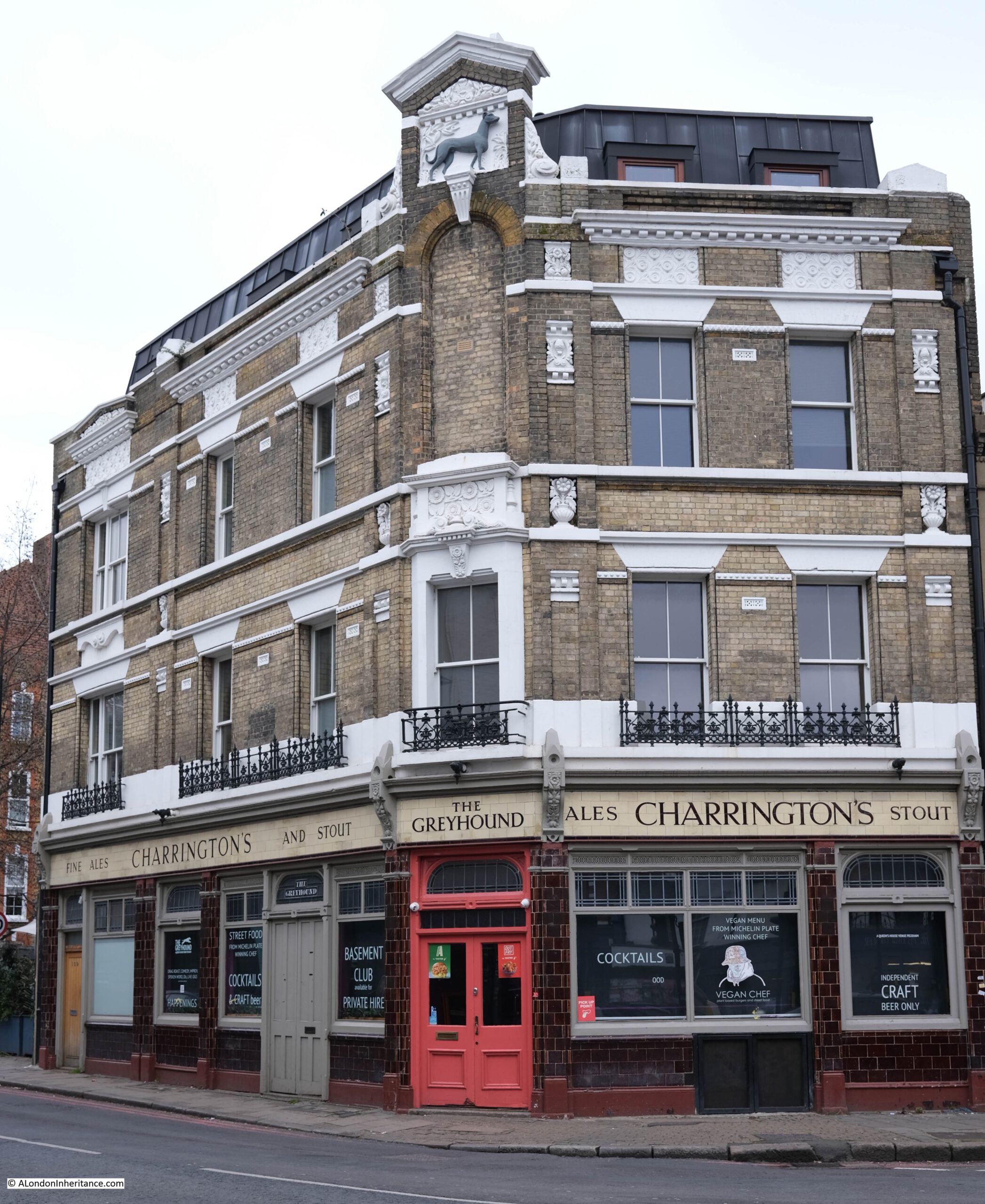
it is good to see that the Greyhound still has the decoration at the top corner of the building, although today it is a rather plain black and white, unlike the colourful decoration in the 1986 photo.
I was hoping the Greyhound would be open as apparently the four bay Victorian bar back fitting remains, which includes a painting of a greyhound, and the name of the pub in gold mosaic.
I cannot find exactly how old the Greyhound is, the earliest mention being a series of adverts in 1821 for an auction, where catalogues could be collected from the Greyhound, Peckham. The pub today looks to be of later 19th century construction, and given the location of the pub at a major cross roads, I suspect there was a pub here for some years before the current building.
Pubs tend to be associated with beer drinking, but in many pubs the emphasis seems to have been on spirits.
When Mr. R. Phillips took over the Greyhound in 1904 he placed an advert in the South London Observer, where he advertised that he was a “Wine and Spirit Merchant”, and that at the pub, the residents of Peckham could purchase “Special blends of Scotch and Irish Whiskies”, and that he was an “Importer and Bonder of Foreign Wines and Liqueur Brandies”.
On the opposite side of Peckham High Street, is another pub;
The Bun House
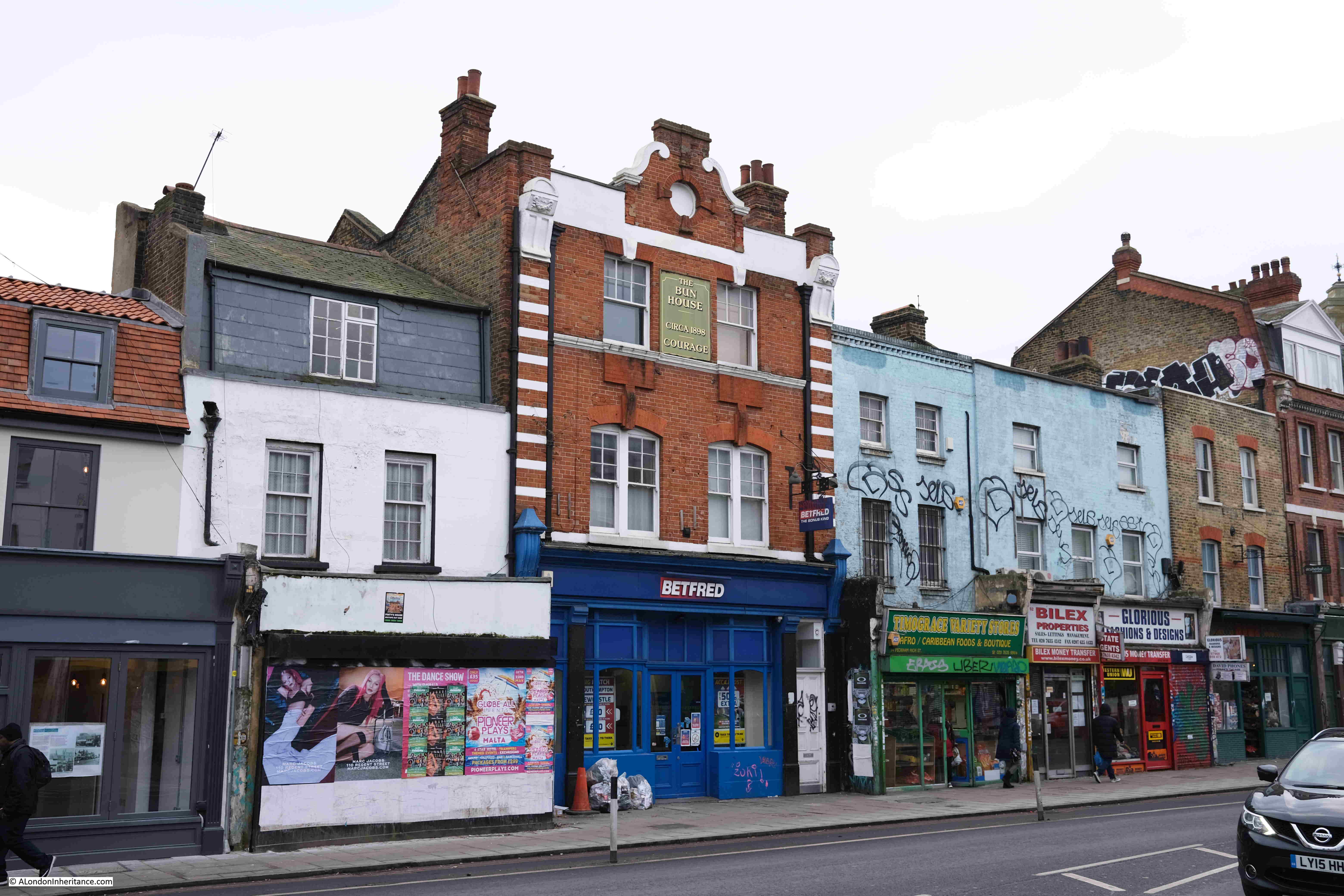
The Bun House has a large sign between the second floor windows with the name of the pub, the date, circa 1898, and the brewery name Courage.
As with the Hope pub, it is now closed (January 2012), with the ground floor being occupied by a betting shop.
The date on the building is 1898, which I assume refers to the current building. I suspect that given the location of the pub, there was an earlier version of the Bun House on the same site. Multiple references to the pub call it Ye Olde Bun House, implying that it was of some age, although perhaps this was just a bit of clever marketing.
I cannot find a source for the name. An earlier landlord for the pub was also a sweet seller, so perhaps it was down to the multiple trades that early pubs were often involved with, selling sweets, buns and alcohol, but again this is pure speculation.
As with the Hope, the Bun House had a long connection with one family, as this report from the South London Observer explains:
30th June 1960: “No more a Deveson behind the bar at Ye Olde Bun House – For 46 years, Ye Olde Bun House, Peckham High Street, has had a Deveson in charge. Next Tuesday, the family connection will be severed when the present licensee, Harry, retires from the trade. Harry, now 50, has been licensee at the Bun House, a wine and spirits house since 1930. The inn was established 62 years ago, rebuilt in 1900, and modernised just before World War II.
Mr Deveson took over in 1930 when his father retired, after being the licensee there from 1914. The Devesons have been gradually leaving the public house business – they once had four premises in South London.
Said Sam Lamb, barman at the Bun House since 1944; ‘I don’t know what I shall do when Mr. Deveson leaves. He has been a good friend’.
What will Mr. Deveson do when he leaves? First of all I’ll have a long rest’ he said ‘I am going to live in Kent so I’ll have plenty of fresh air. I shall miss the company at the Bun House.”
I think I found the report on the death of the original Deveson who retired in 1930:
8th September 1944: “The cremation took place yesterday at Honor Oak of Mr. George Ernest Deveson of East Dulwich, a former licensee of Ye Olde Bun House, Peckham High Street, for 30 years, who died on Saturday. He leaves a widow and six children.
One son, Mr. William E. Deveson is the licensee of The Hope, Rye Lane, Peckham and the Princess of Wales, Elephant and Castle, and another son, Mr. F.H. Deveson is now the landlord of Ye Olde Bun House and also of the Foresters Arms, Nunhead.”
Again, an example of both the landlord trade passing through generations, and the wider family running multiple south London pubs, including the Hope in nearby Rye Lane.
One of the first references I could find to the pub was the following report, showing typical pub entertainment in late 19th century Peckham:
24th November 1894: “HODGES’ HARMONIC SOCIETY. A concert under the auspices of Hodges’ Harmonic Society was held on Thursday evening week, at the Old Bun House, High Street, Peckham, when a good company assembled to participate in the excellent programme which has been provided.”
A short distance east along Peckham High Street was:
The Red Bull
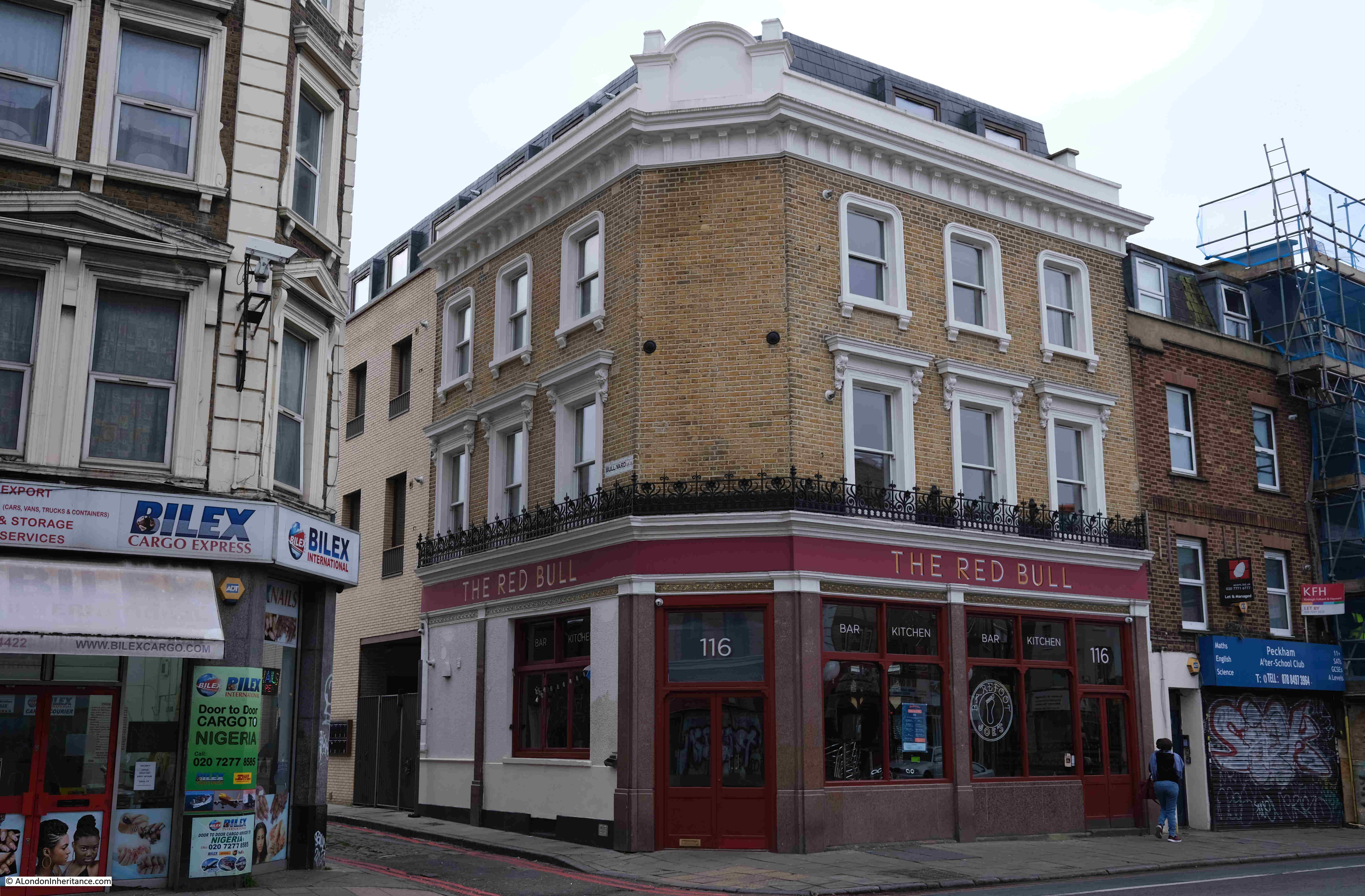
Despite having the name Red Bull, the pub now seems to be known as Barefoot Joe’s Bar, selling cocktails and craft beers. The original Red Bull closed down some years ago and had a number of uses, including retail before opening as a bar in December 2020.
Again, I suspect the Red Bull is much earlier than the current building indicates, as a Red Bull was in Peckham High Street in 1807 when it was mentioned in an advert for a property sale as a place where details of the sale could be collected. The advert shows how at the start of the 19th century, the gardens and orchards of Peckham are starting to be built on:
“A very eligible FREEHOLD ESTATE situate on the north side of the high road from Camberwell, and nearly opposite to the Old Adam and Eve, at the entrance to Peckham; consisting of four pieces of Garden Ground, principally inclosed with brick-walls, and stocked with many standard and wall-fruit trees, a most eligible spot for building upon, having a frontage next the road of 325 feet.”
The Adam and Eve pub mentioned in the advert was to the west of the pubs covered in this post, at 14 Peckham High Street. The building is still there, although the pub has closed.
As the first decades of the 19th century passed, London would cover the fields and integrate what was the village of Peckham into the continuous built environment of south London.
One final pub in this little cluster of pubs around the junction in Peckham High Street:
The Crown
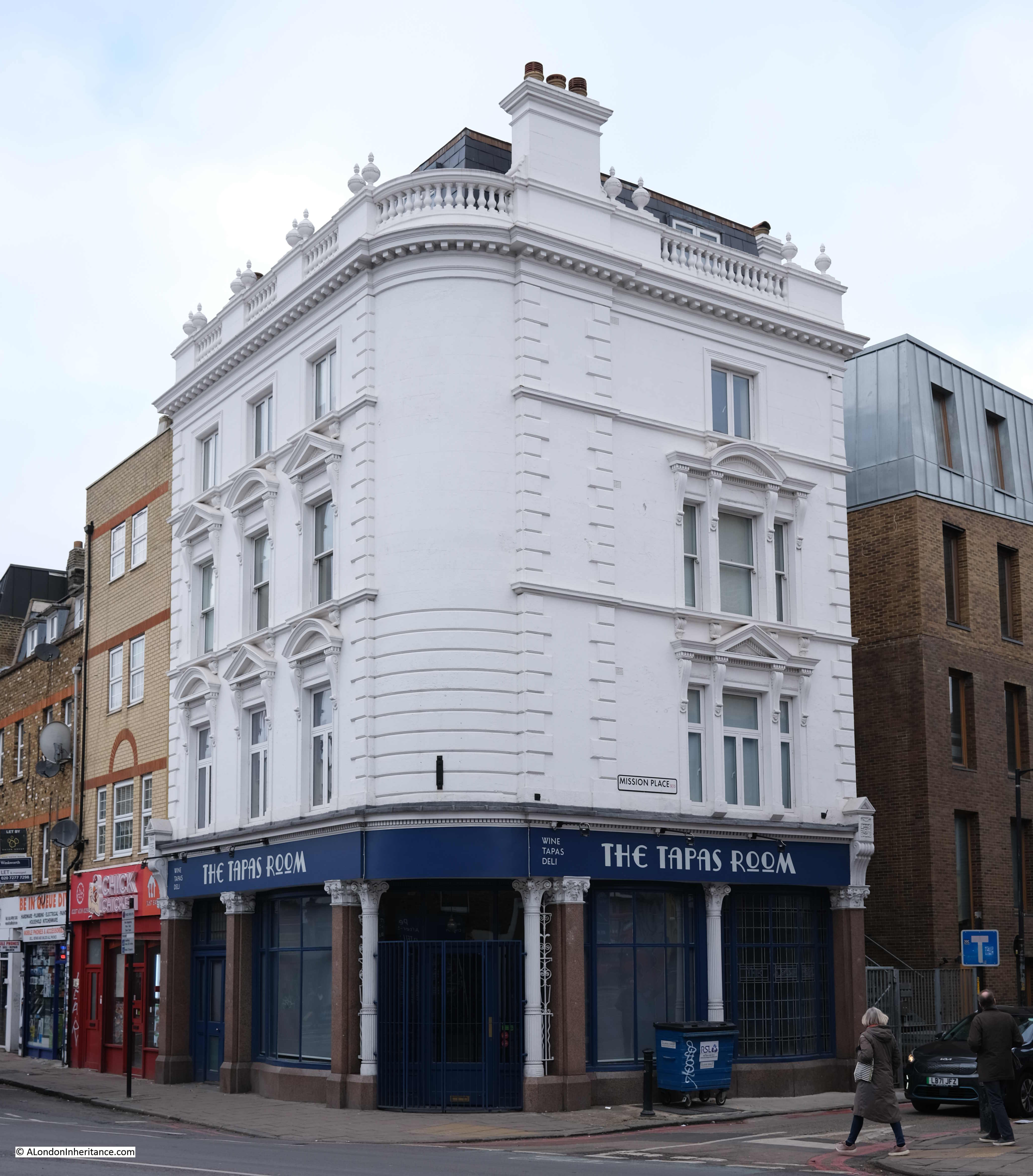
The final pub in my initial exploration of Peckham pubs is the Crown, almost opposite the Red Bull, and the Greyhound is a very short distance to the left of the above photo, so with the Bun House and the Kentish Drovers, there were five pubs clustered around this road junction in Peckham High Street.
The size of the pubs also gives some indication that these were expected to be financially successful businesses.
Whilst the building that the Crown once occupied looks to be of the later part of the 19th century, there was a much older pub here, and a reference to the Crown dating to 1774 is the earliest of any of the references to Peckham pubs.
In September 1774, a Mr. Pittit of the Crown in Peckham wrote a letter to a number of newspapers telling of the benefits of a new elixir.
I suspect that the majority, if not all of the pubs covered in this post are much older than the buildings that remain. This was a significant junction of roads in the early village of Peckham, and would have been the obvious place for pubs, not just to serve local residents, but also for those travelling through the village.
The Crown has some interesting newspaper references, including one where the owner was fined for breaching a key wartime law:
6th December 1940: “Black-out fine at Lambeth on Saturday: Miss Rose Miller, the Crown, Peckham High Street, 15s.“
As was common practice when a new landlord took over a pub, they would advertise in the local papers, always with an emphasis on the quality of their stock:
3rd August 1895: “HENRY S. ROCKE, (Late of the PRINCE ALFRED, 267, Walworth Road). Wine and Spirit Merchant, Importer and Bonder, has purchased THE CROWN, HIGH STREET PECKHAM. Only the best Articles kept on the Premises.”
And perhaps one of Henry Rocke’s business initiatives was to sell Christmas hampers, which he advertised soon after taking over the pub:
2nd October 1895: “Christmas Half-Guinea Hamper, containing bottles of Fine Brandy or Whisky, Best Gin, Jamaica Rum, Old Port, Pale Sherry, and a packet of Best Tea.”
That is six Peckham pubs. The Greyhound looks to be still open. The Kentish Drovers has moved to the opposite side of the road, the rest are closed.
There are many more pubs in Peckham, some open, many closed, but I will save them for another post later in the year. I am pleased to have found the Greyhound and to confirm that the relief at the top of the building is still there, although not so colourful.

